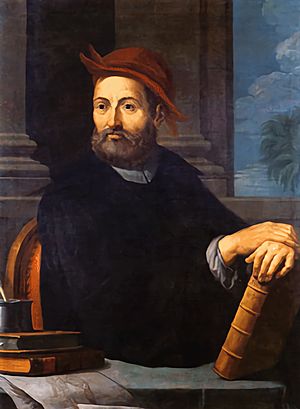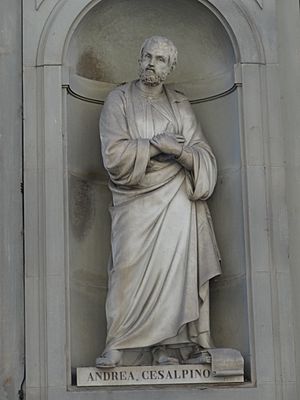Andrea Cesalpino facts for kids
Quick facts for kids
Andrea Cesalpino
|
|
|---|---|
 |
|
| Born | 6 June 1524 Arezzo, Tuscany, Italy
|
| Died | 23 February 1603 (aged 78) |
| Nationality | Florentine |
| Other names | Andreas Cæsalpinus |
| Education | University of Pisa |
| Known for | Quaestionum peripateticarum libri V (1569), De plantis libri XVI (1583) |
| Scientific career | |
| Fields | Medicine |
| Institutions | University of Pisa, University of Rome |
| Influences | Luca Ghini |
| Influenced | Michele Mercati, John Ray |
| Author abbrev. (botany) | Cesalpino |
Andrea Cesalpino (also known as Andreas Cæsalpinus) was an important Italian scientist who lived from 1524 to 1603. He was a physician, a philosopher, and especially a famous botanist. He made big steps in how we understand and classify plants.
Cesalpino was one of the first to group plants based on their fruits and seeds. Before him, plants were often just listed in alphabetical order or by what medicines they could make. In 1555, he became the director of the botanical garden in Pisa, taking over from his teacher, Luca Ghini. He also studied the circulation of blood in the body. While his ideas were different from what we know today, he was thinking about how blood moves long before others like William Harvey.
Contents
Andrea Cesalpino's Life Story
Andrea Cesalpino was born in Arezzo, a city in Tuscany, Italy. He studied at the University of Pisa. There, he learned medicine from R. Colombo and botany from the famous Luca Ghini.
After finishing his studies, Cesalpino taught philosophy, medicine, and botany at the University of Pisa for many years. He also traveled around Italy to find and study different plants. During his time, the first botanical gardens in Europe were being created. The garden in Pisa was started in 1547 by his teacher, Ghini. Cesalpino took over as its director from 1554 to 1558.
Later in his life, Cesalpino moved to Rome. He became a professor of medicine at the University of Rome La Sapienza. He also worked as a doctor for Pope Clement VIII. One of his best students, Michele Mercati, started the botanical garden in Rome around 1566. It's thought that Cesalpino might have helped manage this garden too.
His Important Ideas
Cesalpino was a very deep thinker, and his writings show his genius. Even though his writing style can be a bit difficult to read today, he made many important observations.
Thinking About Philosophy
His most important philosophical book is Quaestionum peripateticarum libri V, published in 1569. In this work, Cesalpino showed he was one of the best students of Aristotle in his time. He explored many ideas about how the world works and how we understand it.
Discoveries in Medicine and the Body
Cesalpino's studies on the circulation of blood are well-known. He was one of the first to suggest that blood moves throughout the body. While his ideas were not exactly like what William Harvey later proved, Cesalpino's work was a big step forward in understanding how our bodies work. He wrote about these ideas in his book Quaestionum medicarum libri duo (1593).
How He Classified Plants
Cesalpino's most famous work is De plantis libri XVI, published in 1583. This book was a huge moment in the history of botany, even before Carl Linnaeus created his famous system. It was dedicated to Grand Duke Francesco I de' Medici. Unlike other plant books of that time, it didn't have pictures.
In this book, Cesalpino laid the groundwork for how we study plant structure and function. He created the first scientific way to classify flowering plants. He looked closely at their flowers, fruits, and seeds. He used these parts to group plants together. This was very clever, especially since he didn't have a microscope yet! His method of using seeds and their containers to classify plants greatly influenced later botanists like John Ray.
Cesalpino also created one of the first herbaria. An herbarium is a collection of dried plants kept for study. His collection, made around 1550–60, is still in existence today. It's kept in the Museo di Storia Naturale di Firenze in Florence. It has 768 different types of plants!
Other Scientific Work
Cesalpino also wrote a valuable book about chemistry, mineralogy, and geology called De metallicis libri tres (1596). In this book, he showed a good understanding of fossils. He believed that fossil shells found on land were left there by the sea long ago.
The plant genus Caesalpinia was named after him by a friar named Charles Plumier. Later, Carl Linnaeus kept this name in his system. This group of plants, part of the Fabaceae family, includes many useful plants. Linnaeus often praised Cesalpino in his own writings, showing how much he respected his work.
See also
 In Spanish: Andrea Cesalpino para niños
In Spanish: Andrea Cesalpino para niños
Images for kids



